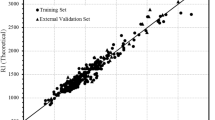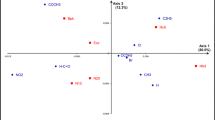Abstract
The core idea behind this study was the utilization of the principal components (PCs) as a substitute of the original dataset of molecular descriptors for the derivatization products of amino acid analogues with n-propyl chloroformate. The derivatives were described through principal component analysis (PCA) with a total of over 1200 different molecular descriptors, split into groups according to their prime chemical characteristic. The form of the chemical space was modeled by PCA and optimized through a supervised procedure; whose quality was tested employing an internal cross-validation leave-more-out methodology supplying the Q2X metric (> 0.90 on most sets). The independent “spaces” formed contributed a total set of 63 variables (their PCs), the potential of which was evaluated through their application in two independent tests and more specifically in the formation of quantitative structure–retention relationships for two different chromatography systems (gas and liquid), based on published experimental data on those systems. The first model was developed through projection to latent structures methodology, while the second on multilinear regression (MLR). In both cases, the new derivatives’ descriptor set formed models of good quality (Q2Y ≥ 0.9), validated through both internal and external test set validation procedures. Their ability to be used along with other variables in simpler modelling methods, like MLR, attests to their potential to be used in models of multivariate system calibration without blowing the dataset out of proportion. Regardless of the selected modelling method, data support their use for the composition of predictive models for analytical purposes.



Similar content being viewed by others
References
Grover M, Singh B, Bakshi M, Singh S (2000) Quantitative structure–property relationships in pharmaceutical research—Part I. Pharm Sci Technol Today 3:28–35
Grover M, Singh B, Bakshi M, Singh S (2000) Quantitative structure–property relationships in pharmaceutical research—Part II. Pharm Sci Technol Today 3:50–57
Katritzky AR, Lobanov VS, Karelson M (1995) QSPR: the correlation and quantitative prediction of chemical and physical properties from structure. Chem Soc Rev 24:279–287
Izenman AJ (2008) Modern multivariate statistical techniques: regression, classification, and manifold learning, 1st edn. Springer, New York
Todeschini R, Consonni V (2009) Molecular descriptors for chemoinformatics, 2nd edn. Wiley, Weinheim
Eriksson L, Johansson E, Kettaneh-Wold N, Trygg J, Wikström C, Wold S (2006) Multi- and megavariate data analysis part 1: principles and applications, 2nd edn. MKS Umetrics AB, Umea
Box GEP, Cox DR (1964) An analysis of transformations. J R Stat Soc Ser B Stat Methodol 26:211–252
Fink EL (2009) The FAQs on data transformation. Commun Monogr 76:379–397
Varmuza K, Filzmoser P, Dehmer M (2013) Multivariate linear QSPR/QSAR models: rigorous evaluation of variable selection for PLS. Comput Struct Biotechnol J 5:1–10
Sneath PHA (1966) Relations between chemical structure and biological activity in peptides. J Theor Biol 12:157–195
Hellberg S, Sjostrom M, Skagerberg B, Wold S (1987) Peptide quantitative structure–activity relationships, a multivariate approach. J Med Chem 30:1126–1135
Jonsson J, Eriksson L, Hellberg S, Sjostrom M, Wold S (1989) Multivariate parameterization of 55 coded and non-coded amino acids. Quant Strut Act Relat 8:204–209
Li SZ, Fu BH, Wang YQ, Liu SS (2001) On structural parameterization and molecular modeling of peptide analogues by molecular electronegativity-edge vector (VMEE): estimation and prediction for biological activity of pentapeptides. J Chin Chem Soc 48:937–944
Mei H, Zhou Y, Sun LL, Li ZL (2004) A new descriptor of amino acid and its application in peptide QSAR. Acta Phys Chim Sin 20:821–825
Liang GZ, Zhou P, Zhou Y, Zhang QX, Li ZL (2006) New descriptors of amino acids and their applications to peptide quantitative structure activity relationship. Acta Chim Sin 64:393–396
Tian FF, Zhou P, Li ZL (2007) T-Scale as a novel vector of topological descriptors for amino acids and its application in QSARs of peptides. J Mol Struct 830:106–115
Abdi H, Williams L (2010) Principal component analysis (overview). Wiley Interdiscip Rev Comput Stat 2:433–459
Hotelling H (1933) Analysis of a complex of statistical variables into principal components. J Educ Psychol 24:417–441
Alterman M, Hunziker P (2012) Amino acid analysis: methods and protocols, methods in molecular biology, 828th edn. Humana Press, New York
Zaikin V, Halket J (2006) Derivatization in mass spectroscopy: soft ionization mass spectrometry of small molecules. Eur J Mass Spectrom 12:79–115
Quirke J, Adams C, Van Berkel G (1994) Chemical derivatization for electrospray ionization mass spectrometry: 1. Alkyl halides, alcochols, phenols, thiols and amines. Anal Chem 66:1302–1315
Danielson ND, Gallagher P, Bao J (2000) Chemical reagents and derivatization procedures in drug analysis. Encyclopedia of analytical chemistry. Wiley, Chichester, pp 7042–7076
Husek P (1998) Chloroformates in gas chromatography as general purpose derivatizing agents. J Chromatogr B 717:57–91
Badawy A, Morgan C, Turner J (2008) Application of the Phenomenex EZ: faast amino acid analysis kit for rapid gas-chromatographic determination of concentrations of plasma tryptophan and its brain uptake competitors. Amino Acids 34:587–596
Kostić Ν, Dotsikas Y, Malenović A, Medenica M (2013) Effects of derivatization reagents consisting of n-alkyl chloroformate/n-alcohol combinations in LC–ESI-MS/MS analysis of zwitterionic antiepileptic drugs. Talanta 116:91–99
Tetko IV, Gasteiger J, Todeschini R, Mauri A, Livingstone D, Ertl P, Palyulin VA, Radchenko EV, Zefirov NS, Makarenko AS, Tanchuk VY, Prokopenko VV (2005) Virtual computational chemistry laboratory-design and description. J Comput Aid Mol Des 19:453–463
Kritikos N, Tsantili-Kakoulidou A, Loukas YL, Dotsikas Y (2015) Liquid chromatography coupled to quadrupole-time of flight tandem mass spectrometry based quantitative structure–retention relationships of amino acid analogues derivatized via n-propyl chloroformate mediated reaction. J Chromatogr A 1403:70–80
Kaspar H, Dettmer K, Gronwald W, Oefner PJ (2008) Automated GC–MS analysis of free amino acids in biological fluids. J Chromatogr B 870:222–232
Picard R, Cook R (1984) Cross-validation of regression models. J Am Stat Assoc 79:575–583
Hotelling H (1931) The generalization of Student's ratio. Ann Math Stat 2:360–378
Wold S, Sjostrom M, Eriksson L (2001) PLS-regression: a basic tool of chemometrics. Chem Int Lab Syst 58:109–130
Rannar S, Lindgren F, Geladi P, Wold S (1994) A PLS kernel algorithm for data sets with many variables and fewer objects. Part 1: theory and algorithm. J Chemom 8:11–125
Hotelling H (1936) Relations between two sets of variates. Biometrika 27:321–377
Wold S (1991) Validation of QSARs. Quant Struct Act Relat 10:191–193
Arlot S, Celisse A (2010) A survey of cross-validation procedures for model selection. Statist Surv 4:40–79
Collingridge DS (2013) A primer on quantitized data analysis and permutation testing. J Mix Methods Res 7:79–95
Rodgers J, Nicewander W (1988) Thirteen ways to look at the correlation coefficient. Am Stat 42:59–66
Farrar D, Glauber R (1967) Multicollinearity in regression analysis: the problem revisited. Rev Econ Stat 49:92–107
Matsumoto M, Nishimura T (1998) Mersenne twister: a 623-dimensionally equidistributed uniform pseudo-random number generator. TOMACS 8:3–30
Matsumoto M, Kurita Y (1992) Twisted GFSR generators. TOMACS 2:179–194
Efron B (1979) Bootstrap methods: another look at the jackknife. Ann Stat 7:1–26
Funding
This study was self-funded, no fund is received.
Author information
Authors and Affiliations
Corresponding author
Ethics declarations
Conflict of interest
No conflict of interest of any kind.
Research involving human or animal participants
This article does not contain any studies with human participants or animals performed by any of the authors.
Additional information
Publisher's Note
Springer Nature remains neutral with regard to jurisdictional claims in published maps and institutional affiliations.
Electronic supplementary material
Below is the link to the electronic supplementary material.
Rights and permissions
About this article
Cite this article
Kritikos, N., Tsantili-Kakoulidou, A., Loukas, Y.L. et al. Novel Molecular Descriptors for the Liquid- and the Gas-Chromatography Analysis of Amino Acids Analogues Derivatized with n-Propyl Chloroformate. Chromatographia 82, 1531–1539 (2019). https://doi.org/10.1007/s10337-019-03767-0
Received:
Revised:
Accepted:
Published:
Issue Date:
DOI: https://doi.org/10.1007/s10337-019-03767-0




